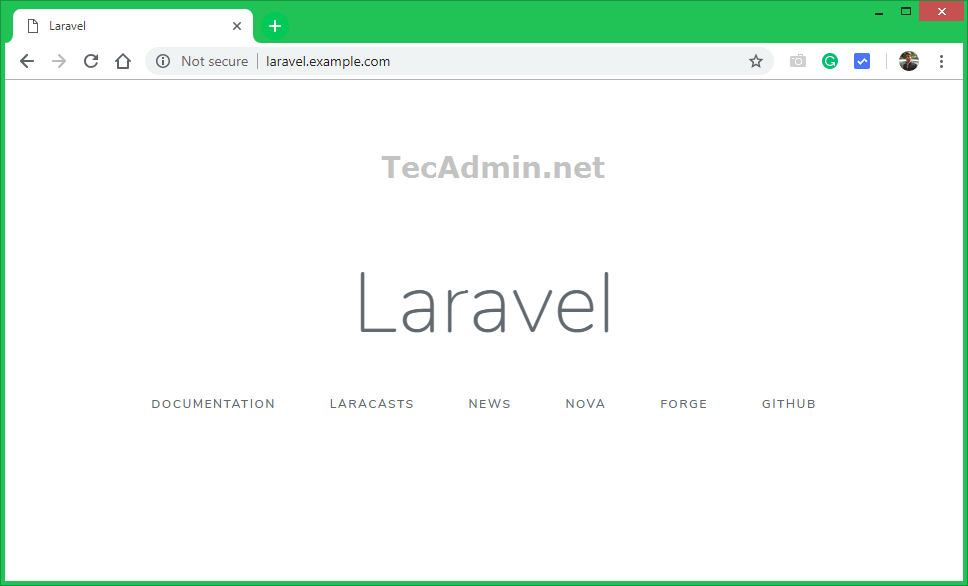Laravel is an open source PHP framework designed for the faster development of MVC web applications in PHP. This article will help you to install Laravel 8 PHP Framework on CentOS/RHEL 7 system.
Step 1 – Setup Yum Repositories
First of all, you need to add REMI and EPEL rpm repositories in your system. these repositories have updated packages. Use one of the below commands as per your OS version and system architecture.
rpm -Uvh https://dl.fedoraproject.org/pub/epel/7/x86_64/Packages/e/epel-release-7-14.noarch.rpm rpm -Uvh http://rpms.famillecollet.com/enterprise/remi-release-7.rpm
Step 2 – Install Apache, MySQL and PHP
Here is short instruction for the installation of LAMP stack. Its required to run the Laravel framework on your CentOS system. Use this guide for the detailed LAMP setup on CentOS
Install Apache
yum --enablerepo=remi,epel install httpd
Install MySQL
yum --enablerepo=remi,epel install mysql-server service mysqld start /usr/bin/mysql_secure_installation
Install PHP
yum --enablerepo=remi,epel install php php-zip php-mysql php-mcrypt php-xml php-mbstring service httpd restart
Step 3 – Install Composer
Composer is required for installing Laravel dependencies. So use below commands to download and use as a command in our system.
curl -sS https://getcomposer.org/installer | php mv composer.phar /usr/bin/composer chmod +x /usr/bin/composer
Step 4 – Install Laravel on CentOS 7
To download latest version of Laravel, Use below command to clone master repo of laravel from github.
cd /var/www git clone https://github.com/laravel/laravel.git
Navigate to the Laravel code directory and use the composer to install all dependencies required for the Laravel framework.
cd /var/www/laravel composer install
Dependency installation will take some time. After that set proper permissions on files.
chown -R apache.apache /var/www/laravel chmod -R 755 /var/www/laravel chmod -R 755 /var/www/laravel/storage
SELinux enabled systems also run the below command to allow writing on the storage directory.
chcon -R -t httpd_sys_rw_content_t /var/www/laravel/storage
Step 5 – Set Encryption Key
Laravel uses a .env file for environment configuration. Use .env file for configuring all the environment variables for your application like the database, SMTP, security key, etc.
cp .env.example .env
Now set the 32-bit long random number encryption key, which is used by the Illuminate encrypter service.
php artisan key:generate Application key set successfully.
You can view the .env file to find the Application key that is configured.
Step 6 – Create Apache VirtualHost
Now add a Virtual Host in your Apache configuration file to access Laravel framework from web browser. To do it edit Apache configuration file /etc/httpd/conf/httpd.conf and add below code at end of file
vim /etc/httpd/conf/httpd.conf
<VirtualHost *:80>
ServerName laravel.example.com
DocumentRoot /var/www/laravel/public
<Directory /var/www/laravel>
AllowOverride All
</Directory>
</VirtualHost>
Restart Apache service and access the Laravel framework using your favorite web browser and start developing a great web application.
service httpd restart
Now access the Laravel website in a web browser.

16 Comments
how to install laravel fremwork version 8.5.4 on apache centos 7
Thaaankss bro its worked for me several times
how to remove the /public in front of the server name?
Hi Paul,
Just point your web server DucumentRoot to the /public directory.
Thanks @Rahul this tutorial worked for me.
After all this is done we try to create a laravel project with the command laravel new project name
But we get -bash: laravel: command not found
How do we make the laravel command globally available in these steps ?
before step2 do this:
1. sudo yum-config-manager –disable remi-php54
2. sudo yum-config-manager –enable remi-php73
because as default centos enable remi-php73
Here are the link I needed to use to make install
rpm -Uvh http://dl.fedoraproject.org/pub/epel/7/x86_64/Packages/e/epel-release-7-12.noarch.rpm
yum –enablerepo=remi,epel install mariadb-server mariadb-libs mariadb
systemctl start mariadb.service
permission denied:
setsebool -P httpd_can_network_connect_db=1
Can’t load when call from http://laravel.example.com/
Easy CentOS 6 install of PHP 7:
yum-config-manager –enable remi-php71
yum update
wget git clone https://github.com/laravel/laravel.git worked for me.
git clone https://github.com/laravel/laravel.git command is not going . it shows git is command cant be find
yum install -y git
Remi repo doesn’t have php 5.5> . in laravel versin 5, this guide will fail.
please update to used webtatic repo also
## Remi Dependency on CentOS 6 and Red Hat (RHEL) 6 ##
rpm -Uvh http://download.fedoraproject.org/pub/epel/6/i386/epel-release-6-8.noarch.rpm
## CentOS 6 and Red Hat (RHEL) 6 ##
rpm -Uvh http://rpms.famillecollet.com/enterprise/remi-release-6.rpm
Here is how I have installed php for laravel
yum install php php-cli php-common php-gd php-imap php-mbstring php-mysqlnd php-pdo php-pecl-jsonc php-pecl-zip php-xml php-pgsql –enablerepo=epel,remi-php56